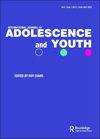Is there a uniform NEET identity in the European Union?
IF 2.2
Q3 PSYCHOLOGY, DEVELOPMENTAL
International Journal of Adolescence and Youth
Pub Date : 2022-04-17
DOI:10.1080/02673843.2022.2065922
引用次数: 3
Abstract
ABSTRACT During the last decade, the policy efforts aiming to tackle the NEET situation (young people who neither study nor work) have increased dramatically in the European Union. Meanwhile, many studies challenged those policies, showing how they failed due to lack of understanding the NEETs. Thus, we analyse the factors that influence the appearance, modification and elimination of a NEET identity. The results reveal the presence of a shared NEET identity in the countries with high NEET rates, despite the considerable differences in the countries’ and NEETs’ characteristics. The NEET rate stands out as the key factor influencing the NEET identity, showing that this identity depends more on economic cycles than on the specific country or its culture.欧盟有统一的啃老族身份吗?
在过去的十年中,旨在解决啃老族(既不学习也不工作的年轻人)问题的政策努力在欧盟急剧增加。与此同时,许多研究对这些政策提出了质疑,表明它们是如何由于缺乏对啃老族的了解而失败的。因此,我们分析了影响啃老族身份的出现、修改和消除的因素。研究结果显示,尽管啃老族和啃老族的特征存在很大差异,但啃老族在啃老率高的国家中存在共同的身份认同。啃老族比率是影响啃老族身份的关键因素,表明这种身份更多地取决于经济周期,而不是特定的国家或其文化。
本文章由计算机程序翻译,如有差异,请以英文原文为准。
求助全文
约1分钟内获得全文
求助全文
来源期刊

International Journal of Adolescence and Youth
PSYCHOLOGY, DEVELOPMENTAL-
CiteScore
8.80
自引率
2.20%
发文量
32
审稿时长
9 weeks
期刊介绍:
nternational Journal of Adolescence and Youth aims to identify, examine and compare particular issues, problems and policies related to adolescents and youth throughout the world. Subject areas covered include psychological growth and development, health and medical care, delinquency, social policy, employment and unemployment, education and training, spiritual and physical development, leisure, family relationships, sex education, homelessness. The Journal will be of interest to researchers in those areas, university and other higher education institutions, as well as to international, central and local government and voluntary organizations and field work agencies.
 求助内容:
求助内容: 应助结果提醒方式:
应助结果提醒方式:


